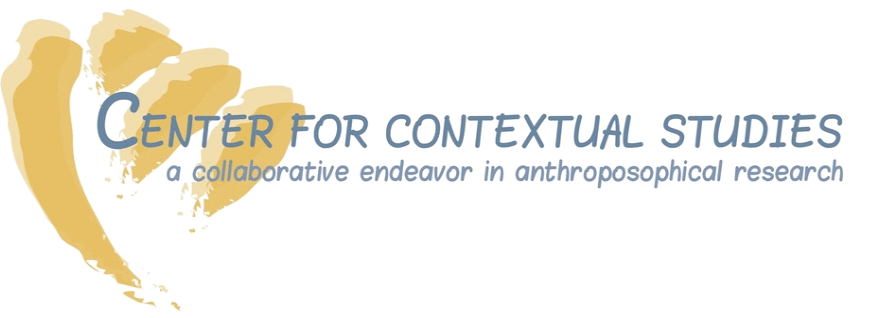Dear Friends!
Our warmest wishes for a creative new year, full of exciting discoveries and insights!
In the coming year the central focus here at the Center for Contextual Studies will continue to be the nature of the etheric and the role our understanding of the etheric plays in education. The winter conferences in Santa Rosa, the gathering for younger teachers this spring and the planned summer seminar in Hillsdale, NY will all address different aspects of the question of the etheric in education and how we can cultivate a stronger relationship to these forces of formative vitality.
In looking at the three educational periods that make up a child’s and young person’s life, Steiner emphasizes that in each period there are aspects that need to develop on their own, in a certain sense naturally, and others that must be addressed explicitly. He reminds us of the growth and development of the fetus in the maternal womb: “Everything that must evolve in the etheric body before the seventh year (during the first of the three educational periods) – ideas, habits, memory, and so on – all of this must develop “by itself”, just as the child’s eyes and ears develop within the mother’s body without the influence of external light.” Each birth is preceded by a period of gestation. During the subsequent periods of gestation, development of specific aspects of the child’s being take place within a protective environment, within a sheltered space. It is within this space that the first stages of maturation occur. Our challenge is to create the environment within which it can occur “naturally”.
Following the moment we normally think of as birth, the child’s physical organism enters into a new and radically different relationship with what is to be experienced in the sense world. Light and sound, smells and tastes, textures and presences become part of the newborn’s experience. The child now becomes a participant in the sense reality of the earthly world. This participation is so intimate and immediate that what the child experiences in his or her surroundings have a formative effect on the maturational processes taking place in the bodily organism. As Steiner puts it: “The physical organs shape themselves through the influence of the physical environment.”
Although Steiner’s studies of the senses were at this time still in their infancy (the first sketch of the full spectrum of human sense experience would come to fragmentary form in 1910) his understanding of the nature of sense experience leads him to include the inner gestures of human action – the moral signature of what we do – as one of the formative aspects of the child’s physical surroundings: “ “’Physical environment’ must, however, be understood in the widest sense imaginable. It includes not just what happens around children in the material sense, but everything that occurs in their environment – everything that can be perceived by their senses, that can work on the inner powers of children from the surrounding physical space…Good sight will develop in children if their environment has the proper conditions of light and color, while in the brain and blood circulation the physical foundations will be laid for a healthy moral sense if children see moral actions in their environment.”
As the child’s newly gained participatory, imitative relationship to the sense-accessible earthly world influences the maturation of the physical organism, the child’s etheric organism remains in a form of protective gestation. “Everything that must evolve in the etheric body before the [end of the first developmental period] – ideas, habits, memory and so on – all of this must develop ‘by itself’, just as the eyes and ears develop within the mother’s body without external stimulation.”
We have learned much about the nature of pregnancy and the adverse effect environmental influences can have on fetal development. The deleterious effect environmental toxins may have on embryonic development has been the topic of innumerable studies since Rachel Carson first published Silent Spring. We have not paid as much attention to the toxic effects the etheric environment may have on the foundational development of children’s inner life. As we ponder the proper response to the ever-growing presence of digital technology in children’s experienced life-world, it seems appropriate to remedy this.
As long as we look for the sources of life and consciousness within the physical properties of earthly substance and the causal relationships that come about between living organisms, we remain unable to fathom the inner formative qualities of relationship that exist within the living whole. The riddle of the etheric in education begins to take on shape when we as teachers begin to experience our own states of consciousness as integral to our children’s experienced life-world. Only by understanding the nature of our own ways of thinking can we begin to recognize the effects of contemporary ‘civilization’ on the coming into appearance of the child’s thought organism.
by Jon McAlice
(All quotations from the essay: The Education of the Child in Light of Anthroposophy, GA 34, 1907)
